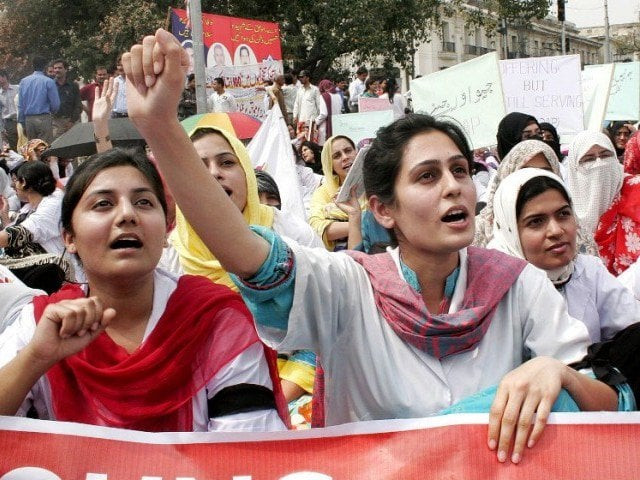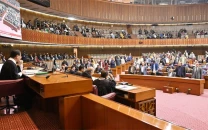Pakistan second worst on global gender parity index
Pakistan has smallest share of senior managerial, and legislative roles

Pakistan is the second worst country in the world in terms of gender parity, ranking 145 out of 146 countries in the Global Gender Gap Index report released by the World Economic Forum (WEF) on Wednesday.
The Geneva-based organisation’s annual report tracked disparities between the genders in 146 countries across several areas including education, health, economic opportunity and political empowerment.
The Global Gender Gap Report 2022 is live.
— World Economic Forum (@wef) July 13, 2022
Contained inside, the world's most gender-equal countries, where the gap still needs closing, and the actions being taken to do so.
Read it here: https://t.co/WI3JsAj6fM#gendergap22 pic.twitter.com/hkddaGUsOx
The top five worst countries are the Democratic Republic of Congo, Iran, Afghanistan, Pakistan and Chad, while the top five countries with gender parity are Finland, Norway, New Zealand, and Sweden.
According to the report, Pakistan was among the five countries with a gender gap greater than 5%, with the other countries being Qatar, Azerbaijan, China and India.
It said that Pakistan has closed 56.4% of the gender gap in 2022 — the highest overall level of parity the country has posted since the report launched in 2006.
Pakistan has made “significant improvement” across three subindexes, with the highest positive variation on economic participation and opportunity, it stated.
The country ranked 145 on economic participation and opportunity, 143 on health and survival, 135 on educational attainment and 95 on political participation.
Read Factbox: Do women enjoy equality?
“While wage equality carries the highest gender gap score among economic indicators, advances were also reported in estimated earned income, where women’s earnings increased 4pc compared to 2021.”
However, the report noted, women’s participation in the labour force declined in 2022 and the shares of both men and women in senior and professional categories also saw a downturn.
“Gender parity scores for literacy, secondary and tertiary education enrolment all rose,” the report added.
Pakistan is the country where women have the smallest share of senior, managerial and legislative roles at a mere 4.5pc, according to the report.
“However, between 2021 and 2022 the share of women in professional and technical roles as well as in senior, legislative and managerial roles increased slightly (6.7 percentage points and 5.4 percentage points, respectively). Pakistan is the country where women have the smallest share of senior, managerial and legislative roles (4.5%), compared to Jamaica, where women represent 56.6% of workers in that category, or Togo, which has the highest share of women in senior roles, at 70.1%. Women were less than 18% of professional and technical workers in Chad, compared to 41% in Rwanda or 70% in Belarus,” the report read.
Meanwhile, in secondary education enrolment, 16 countries reported gender gaps larger than 10 percentage points – 13 of them in Sub-Saharan Africa, two in South Asia (Pakistan and Afghanistan), and one in East Asia and the Pacific (China). In tertiary education, 29 countries closed less than 90% of the gender gap in enrolment – and these countries are concentrated in Sub-Saharan Africa, South Asia and East Asia and the Pacific.
Also read Pakistan ranked second-last on gender equality index
Of this year’s sample, the only region where performances have moved further toward parity is Latin America and the Caribbean, the report added.
South Asia
Among the eight regions covered in the report, South Asia ranked the lowest, with only 62.4% based on no constant sample of the gender gap closed.
The lack of progress since the last edition extends the wait in South Asia to close the gender gap to 197 years, with broad stagnation across the gender parity scores of most countries.
Bangladesh and Nepal lead regional performance, with over 69% of their gender gaps closed, while Afghanistan registered the region’s and world’s lowest level of overall gender parity, with a score of 43.5%.
The report further said that South Asia has the widest gender gap on economic participation and opportunity, having closed only 35.7% of this gender gap. While the subindex score is an improvement of 1.8 percentage points from last year, there are considerable country divergences that anchor the result as the lowest among all regions.
Afghanistan has only attained 17.6% parity on this subindex, well below the highest score of Nepal, at 64.1%. Highly populated countries are for the most part driving variation within this subindex, according to the report.
“For example, increases in the share of women in professional and technical roles were most notable in Nepal, Bangladesh and India. On the other hand, the shares in Iran, Pakistan and Maldives regressed, with less impact on overall regional performance.”



















COMMENTS
Comments are moderated and generally will be posted if they are on-topic and not abusive.
For more information, please see our Comments FAQ